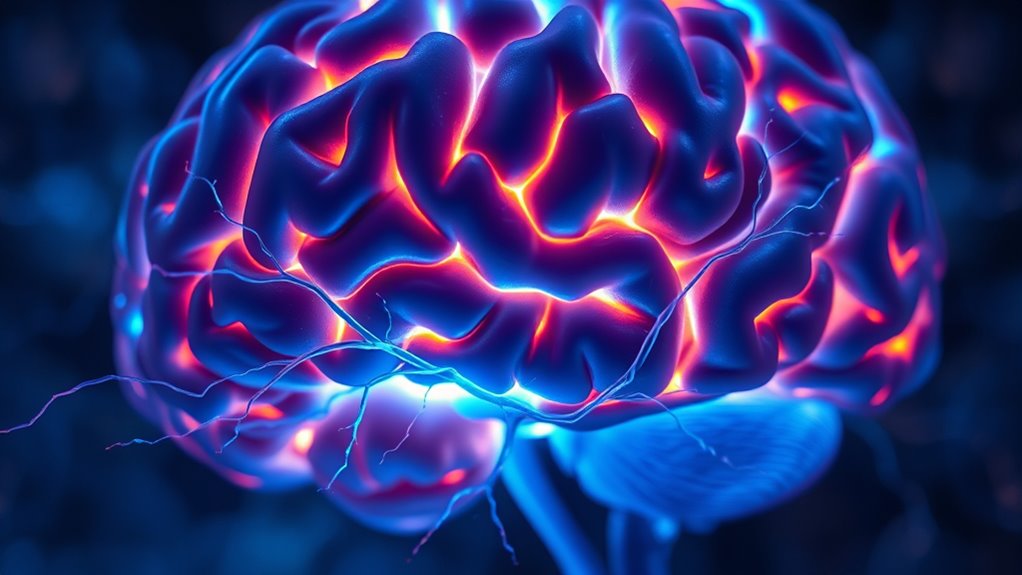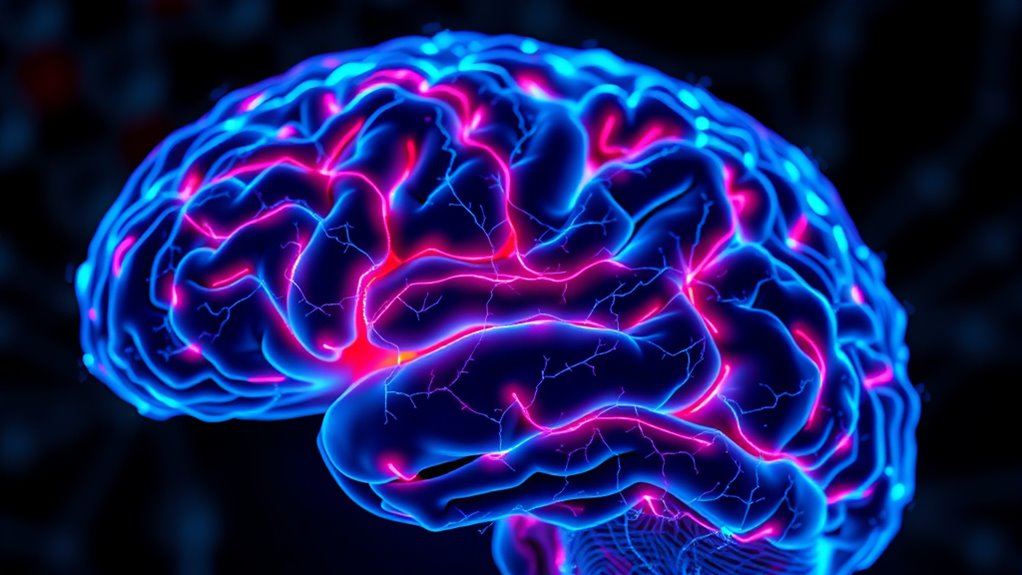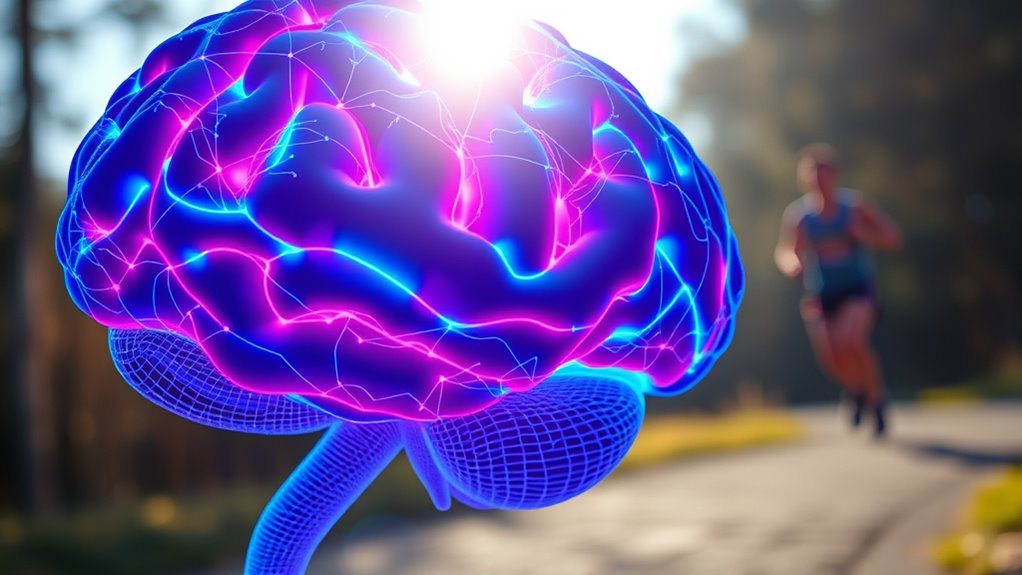Your brain constantly monitors effort, fatigue, and feedback from your muscles and heart to set your pace. It uses neural pathways and regions like the motor cortex, basal ganglia, and cerebellum to coordinate movement, while the autonomic system adjusts heart rate and breathing. Motivation and perception influence how you perceive effort and decide to speed up or slow down. If you keep exploring, you’ll discover more about how your brain fine-tunes your performance.
Key Takeaways
- The brain monitors effort, fatigue, and internal feedback to regulate pacing and prevent overexertion.
- Neural pathways, including motor and prefrontal cortex, adjust effort based on goals and sensory cues.
- Neurotransmitters like dopamine and serotonin influence motivation, fatigue perception, and effort regulation.
- The autonomic nervous system automatically modulates heart rate and respiration to support pacing strategies.
- Feedback loops from muscles and joints inform the brain to fine-tune effort and sustain optimal speed.
The Brain’s Role in Monitoring Physical Effort

While you’re engaging in physical activity, your brain continuously monitors your effort levels through specific regions that assess fatigue and exertion. During this process, your mind might wander, but your brain quickly redirects focus to regulate how hard you’re pushing yourself. Emotional regulation plays a vital role here, helping you manage feelings of discomfort or frustration that arise as fatigue sets in. These brain areas assess signals from your muscles and heart, interpreting them to determine if you’re nearing your limit or should ease up. This internal cue processing influences your perception of effort, guiding your pacing decisions. Additionally, the brain’s ability to process interoceptive signals ensures that you remain aware of internal cues that inform your effort level. By balancing awareness of physical cues with emotional responses, your brain ensures you maintain an ideal effort level without overexerting, keeping you in control throughout your activity. Furthermore, research indicates that neuroplasticity allows these monitoring mechanisms to adapt based on experience, improving your pacing over time.
How the Central Nervous System Regulates Pace

Your central nervous system coordinates your pace through specific neural pathways that process effort and timing. Brain regions like the motor and prefrontal cortex play key roles in adjusting your speed based on goals and feedback. Additionally, your autonomic nervous system influences how your body responds to maintain or change pace during activity. The self-regulating system adapts your pacing to environmental and internal cues, ensuring optimal performance. Advances in understanding brain regulation mechanisms have shed light on how neural circuits fine-tune activity levels during different tasks. Moreover, the nervous system’s response is essential for adapting to unexpected changes in the environment, allowing for flexible pacing adjustments. Recognizing the influence of beauty hours in retail environments can also affect your mood and motivation, indirectly impacting your pacing during activities.
Neural Pathways for Pace
The central nervous system (CNS) plays a crucial role in regulating pace by precisely coordinating signals between the brain and muscles. Neural pathways form the communication network that enables this process, transmitting information about your movement, effort, and fatigue. When you set a pace, sensory neurons relay data from muscles and joints to the spinal cord and brain, creating a feedback loop essential for pace regulation. These pathways ensure your muscles respond quickly to changes, whether speeding up or slowing down. They also integrate signals from various parts of the CNS, allowing you to maintain a steady rhythm or adjust as needed. Additionally, high refresh rates in neural signaling allow for more responsive control of movement, which is vital for accurate pacing. Understanding these neural pathways highlights how your brain and nervous system work seamlessly to control pacing during physical activity.
Role of Brain Regions
Multiple brain regions coordinate to regulate your pace during physical activity, ensuring you maintain or adjust your rhythm as needed. The prefrontal cortex, responsible for cognitive control, helps you plan and adapt your pace based on goals or feedback. The motor cortex executes movement commands, while the basal ganglia fine-tune timing and smoothness, leveraging brain plasticity to optimize performance. The cerebellum monitors coordination and error correction, adjusting your rhythm dynamically. These regions work together seamlessly, allowing you to respond to changing conditions. Your brain’s plasticity enables learning and refinement of pacing strategies over time, strengthening neural connections involved in pace regulation. Additionally, understanding how attention influences these processes can help improve your ability to stay focused and maintain optimal pacing during physical activities. This integrated network ensures your movement remains purposeful, flexible, and efficient during every step of your activity.
Autonomic Nervous System Influence
The autonomic nervous system, a essential part of the central nervous system, automatically adjusts your pacing by regulating physiological responses that support sustained activity. Through autonomic regulation, it controls heart rate, breathing, and blood flow, ensuring your body remains balanced during exercise or stress. When you start to push harder, your stress response activates, prompting the sympathetic branch to increase alertness and energy delivery. Conversely, during recovery, the parasympathetic branch slows things down, helping you conserve energy and restore calm. This seamless coordination allows you to maintain a steady pace without conscious effort, as your nervous system constantly monitors and adjusts internal functions. In this way, your autonomic nervous system plays a fundamental role in setting and sustaining your running speed.
Neural Pathways Involved in Movement Control

Understanding how your brain controls movement involves exploring a complex network of neural pathways. These pathways coordinate signals from various brain regions, allowing smooth, precise motion. Neural plasticity enables these connections to adapt, refining your pacing over time. Sensory integration helps your brain interpret feedback from your muscles, joints, and environment, ensuring accurate control. Key pathways include:
- Corticospinal tract – carries voluntary movement commands from the motor cortex to the spinal cord.
- Basal ganglia circuits – regulate initiation and smoothness of movement.
- Cerebellar pathways – coordinate timing and balance, adjusting movements in real-time.
- Brainstem connections – manage posture and automatic responses.
Together, these pathways form a dynamic system, adapting through neural plasticity to optimize your pacing and movement control.
The Impact of Motivation and Perception on Pacing

Motivation and perception play essential roles in shaping how you pace yourself during physical activity. Your motivation influences your drive, pushing you to maintain or adjust your speed based on goals, whether for performance or enjoyment. Perception affects how you interpret signals from your body, such as fatigue or pain, which can lead you to speed up or slow down. If you perceive a task as achievable, your brain is more likely to set a faster pace. Conversely, negative perception or doubts can cause you to subconsciously ease off. These mental factors directly impact your pacing decisions, often more than external cues. Understanding how motivation perception intertwine helps you harness your mindset to optimize performance and sustain effort during your activity.
Feedback Loops Between Muscles and the Brain

Feedback loops between muscles and the brain are essential in regulating pacing during exercise. Your muscles send continuous muscle feedback and reflex responses that inform your brain about their state. This real-time data helps your brain adjust effort levels to prevent injury and optimize performance.
Muscle-brain feedback loops regulate pacing, preventing injury and enhancing performance during exercise.
Consider these aspects:
- Muscle feedback provides information on tension, fatigue, and strain.
- Reflex responses rapidly react to sudden changes, like a cramp or imbalance.
- The brain interprets this feedback to modulate muscle activation.
- This loop maintains efficiency and prevents overexertion, ensuring you pace yourself effectively.
The Influence of Brain Chemistry on Endurance

Your brain’s chemistry plays a vital role in how long you can push through fatigue. Neurotransmitters like serotonin and dopamine influence your motivation and alertness, while hormones affect your energy levels. Understanding this balance can help you optimize your pacing and endurance.
Neurotransmitters and Fatigue
Have you ever wondered how your brain chemistry influences your physical endurance? Neurotransmitter influence plays a key role in fatigue mechanisms, affecting when and how you feel tired. Certain chemicals, like serotonin and dopamine, regulate your motivation and perceived effort, impacting your pacing. As these neurotransmitters fluctuate, they alter your fatigue thresholds, making you push harder or slow down. To understand this better:
- Serotonin buildup can increase sensations of fatigue, prompting a slowdown.
- Dopamine boosts motivation, delaying fatigue and enhancing endurance.
- Norepinephrine influences alertness, affecting how you perceive effort.
- Imbalances in neurotransmitter levels can accelerate exhaustion or sustain effort longer.
Hormonal Impact on Pacing
Hormones released by the brain play an essential role in regulating your endurance and pacing during physical activity. When you push your limits, hormonal fluctuations influence how you perceive effort and maintain your speed. The adrenaline response, in particular, triggers a surge of energy, sharpening focus and reducing pain perception. This hormonal boost helps you sustain effort during critical moments.
| Hormone | Effect on Pacing |
|---|---|
| Adrenaline | Increases alertness, delays fatigue |
| Endorphins | Reduce pain, enhance motivation |
| Cortisol | Manages stress, can impair endurance |
| Serotonin | Affects mood, impacts pacing consistency |
Brain Chemistry Balance
Brain chemistry balance plays a crucial role in determining how well you can sustain endurance during physical activity. When your brain’s chemical environment is ideal, it enhances motivation, reduces fatigue, and boosts neural plasticity—the brain’s ability to adapt and strengthen pathways related to endurance. Key neurotransmitters like dopamine influence your brain reward system, encouraging you to push through discomfort. Imbalances can lead to decreased motivation or increased perception of effort. To enhance your brain chemistry:
- Maintain consistent physical activity to stimulate dopamine release.
- Prioritize quality sleep to support neurotransmitter synthesis.
- Consume a balanced diet rich in nutrients that promote neural plasticity.
- Manage stress to prevent cortisol from disrupting chemical balance.
This balance fuels your endurance and helps set your brain’s pacing during activity.
Adaptive Pacing Strategies and Neural Flexibility

Adaptive pacing strategies rely on the brain’s ability to dynamically adjust effort levels in response to changing conditions, highlighting neural flexibility as a key factor. Your brain uses neural adaptation to modify pacing based on real-time feedback from your body and environment, allowing you to maximize performance without conscious effort. This pacing flexibility helps you respond to fatigue, terrain changes, or unexpected obstacles, maintaining efficiency and preventing burnout. By constantly recalibrating your effort, your brain ensures you stay within your ideal range, even during unpredictable situations. This neural adaptability is essential for effective pacing, enabling you to fine-tune your effort levels and sustain activity longer. Understanding this process reveals how your brain’s flexibility directly influences your ability to pace effectively across varied conditions.
Practical Implications for Athletes and Fitness Enthusiasts

Understanding how neural flexibility influences pacing can help athletes and fitness enthusiasts optimize their training and performance. Enhancing neural efficiency and cognitive flexibility allows you to adapt quickly to changing conditions and maintain ideal speed. To improve pacing:
- Practice varied training routines that challenge your brain’s adaptability.
- Incorporate mindfulness and mental focus exercises to boost neural efficiency.
- Use real-time feedback, like heart rate monitors, to refine your pacing strategies.
- Develop mental resilience to stay flexible and adjust pace when fatigue or obstacles arise.
Frequently Asked Questions
How Does Fatigue Alter Neural Signals During Prolonged Exercise?
During prolonged exercise, fatigue alters neural signals by causing neural fatigue, which weakens the communication between your brain and muscles. As your muscles tire, your brain adapts its signals through signal adaptation, reducing muscle activation to prevent damage. This process helps manage energy but also leads to decreased performance. You may notice a decline in motivation or coordination, as your nervous system adjusts to ongoing fatigue, impacting overall exercise efficiency.
Can Mental Training Change the Brain’s Pacing Mechanisms?
Imagine your mind as a coach, guiding your body’s pace. Yes, mental training can change your brain’s pacing mechanisms through neural plasticity. With consistent mental conditioning, you strengthen neural pathways that optimize timing and effort, helping you push past fatigue and maintain focus. This mental rewiring allows you to control your pace better, transforming how your brain responds during exercise, making each session more efficient and resilient.
What Role Do Subconscious Processes Play in Pacing Decisions?
Subconscious processes markedly influence your pacing decisions through automatic regulation and subconscious cues. You might not realize it, but your brain constantly monitors factors like fatigue, breathing, and muscle strain, adjusting your speed without conscious thought. These subconscious cues help you maintain a steady pace, ensuring efficiency and endurance. Recognizing how automatic regulation works can help you better harness your instincts and improve your pacing strategies over time.
How Do Individual Differences in Brain Structure Affect Pacing Strategies?
Imagine your brain as a dynamic landscape where neural variability shapes your pacing strategies. Individual differences in brain structure influence how your mind adapts and responds to movement, like unique rivers carving distinct paths. Brain plasticity allows these pathways to shift and evolve, affecting your rhythm and speed. You naturally develop personalized pacing patterns based on your neural architecture, making every runner’s tempo uniquely their own.
Are There Specific Brain Regions Linked to Perceived Exertion?
You might wonder if specific brain regions influence perceived exertion. It’s linked to neural pathways that process sensory integration, especially in areas like the insula and anterior cingulate cortex. These regions help your brain interpret signals from muscles and lungs, giving you a sense of effort. When these pathways function efficiently, you might perceive exertion differently, influencing how you pace yourself during physical activity.
Conclusion
Understanding how your brain sets your pace helps you push further, adapt better, and perform stronger. Recognize how your mind monitors effort, how motivation influences movement, and how feedback shapes endurance. Embrace neural flexibility, harness brain chemistry, and develop adaptive strategies. By tuning into your brain’s signals, you take control, optimize performance, and release your full potential. Your brain’s pace-setting power is your greatest tool—use it to move smarter, faster, and further.









